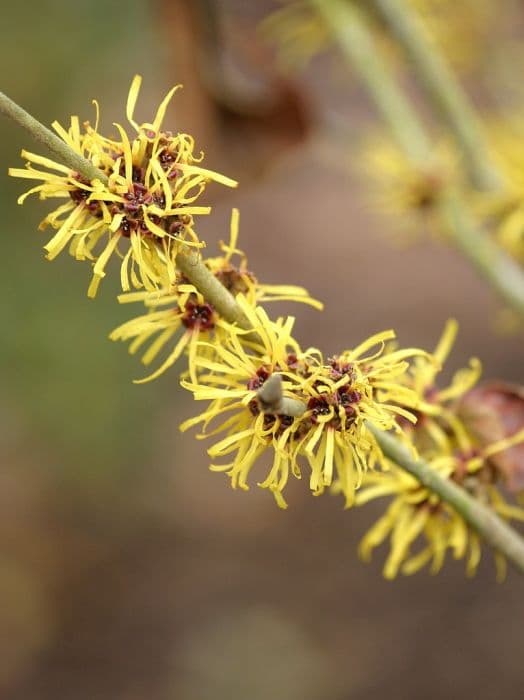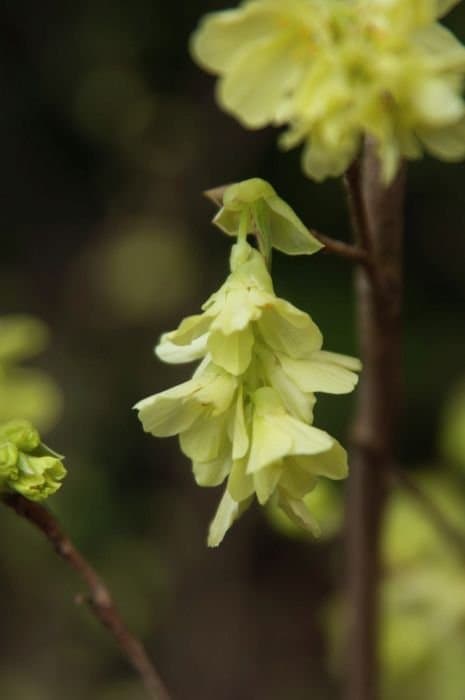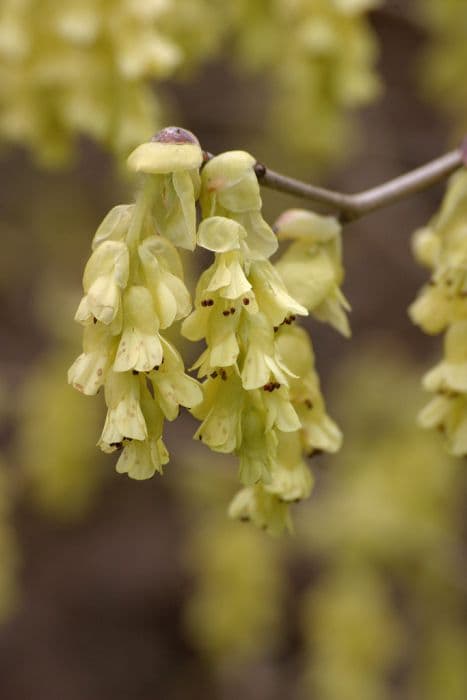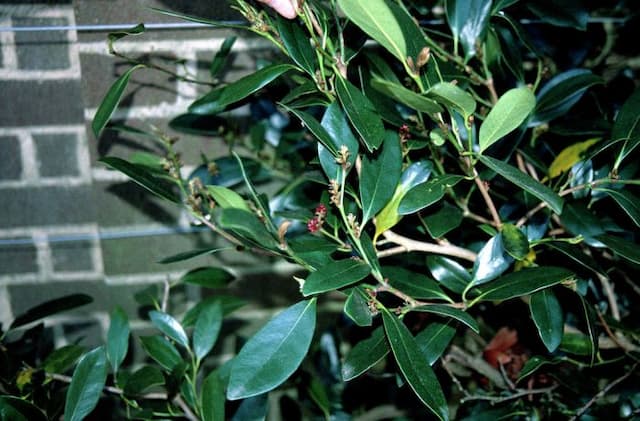Chinese witch hazel Hamamelis mollis 'Jermyns Gold'

ABOUT
'Jermyns Gold' is a variety of Witch Hazel that stands out for its striking appearance, characterized by vibrant flowers and pleasant foliage. The flowers are particularly noteworthy; they boast a sunny, golden-yellow hue that captures the eye, especially during the winter to early spring months when they bloom. These ribbon-like petals curl and twist, giving the flowers a unique, fringed look that adds texture and interest to the winter garden. The blossoms are also fragrant, emitting a sweet, spicy scent that can be quite delightful on a cool day. The leaves of 'Jermyns Gold' Witch Hazel further contribute to its ornamental appeal. They emerge with a fresh green color in the spring, providing a lush background for the blossoms. As the growing season progresses, the foliage takes on a more substantial presence. In the fall, the leaves transition into a spectacle of shades, often displaying a range of yellow to orange and occasionally even red tones before they fall off for the winter. Overall, 'Jermyns Gold' is admired for the brightness it brings to the garden during times when few other plants are flowering, and for its colorful, seasonally changing foliage that complements its cheerful blooms.
About this plant
 Names
NamesFamily
Hamamelidaceae
Synonyms
Chinese Witch Hazel, Jermyns Gold Witch Hazel
Common names
Hamamelis mollis 'Jelena', Hamamelis x intermedia 'Jelena'
 Toxicity
ToxicityTo humans
Witch Hazel is not typically considered toxic to humans. There are no well-documented cases of poisoning from ingesting the Witch Hazel plant. However, as with any plant material, individuals may have allergies or sensitivities that could lead to adverse reactions. Consumption of plant parts in large quantities could potentially cause stomach upset or discomfort due to the plant's astringent properties.
To pets
Witch Hazel is generally considered non-toxic to pets as well. It does not contain any known toxic compounds that would harm cats or dogs if they were to ingest parts of the plant. However, ingestion of any plant material could potentially cause mild gastrointestinal upset in some pets, including symptoms such as vomiting or diarrhea. If a pet ingests large amounts of the plant and exhibits symptoms, it is advisable to consult a veterinarian.
 Characteristics
CharacteristicsLife cycle
Perennials
Foliage type
Deciduous
Color of leaves
Green
Flower color
Yellow
Height
12 feet (3.66 meters)
Spread
12 feet (3.66 meters)
Plant type
Shrub
Hardiness zones
5
Native area
China
Benefits
 General Benefits
General Benefits- Ornamental Value: Hamamelis mollis 'Jermyns Gold', commonly known as Witch Hazel, has an attractive display of bright yellow flowers that are particularly striking during the winter months when little else is in bloom.
- Scent: Witch Hazel is well known for its fragrant flowers, which can bring a pleasant aroma to gardens during its flowering season.
- Wildlife Support: The flowers provide nectar for pollinators such as bees during the late winter to early spring when few other nectar sources are available.
- Seasonal Interest: Witch Hazel has year-round interest thanks to its flowers during winter, lush green foliage in the spring and summer, and colorful fall foliage in the autumn.
- Ease of Care: Witch Hazel is generally low-maintenance, requiring minimal pruning and able to withstand a variety of soil conditions once established.
- Drought Resistance: Once established, it is moderately drought tolerant, making it suitable for gardens in areas with occasional water restrictions.
- Privacy and Screening: With its bushy habit and the ability to reach moderate heights, Witch Hazel can be used as a privacy screen or to hide unattractive views.
 Medical Properties
Medical Properties- This plant is not used for medical purposes.
 Air-purifying Qualities
Air-purifying QualitiesThis plant is not specifically known for air purifying qualities.
 Other Uses
Other Uses- Witch Hazel 'Jermyns Gold' branches can be used in winter floral arrangements for their vibrant yellow flowers and interesting branch structure, adding a unique touch to indoor decorations.
- The extract of Witch Hazel 'Jermyns Gold' is sometimes utilized in the production of natural dyes for fabrics, producing soft yellow hues.
- In photography, the tannins from Witch Hazel can be employed in the alternative process of anthotype to create plant-based photographs.
- Witch Hazel 'Jermyns Gold' can be planted as a natural privacy screen due to its dense growth, offering seclusion in gardens throughout the seasons.
- The twigs and bark of the plant are sometimes used in smoking meats to infuse a subtle fragrance and flavor.
- Fragrant sachets containing dried Witch Hazel petals can be placed in drawers or closets to impart a pleasant aroma to linens and clothing.
- As a natural insect repellent, growers may plant Witch Hazel 'Jermyns Gold' to help deter certain pests from the garden without the use of chemicals.
- During the winter, the flowering of Witch Hazel 'Jermyns Gold' can provide a vital source of pollen and nectar for bees and other pollinating insects that are active during warmer spells.
- Filmmakers and stage designers use Witch Hazel 'Jermyns Gold' for its aesthetic appeal in creating natural-looking sets or for its potential symbolism in scenes.
- Artists may use the leaves and blooms of Witch Hazel 'Jermyns Gold' as subjects or inspiration in botanical illustration due to their distinctive shape and color.
Interesting Facts
 Feng Shui
Feng ShuiThe Witch Hazel is not used in Feng Shui practice.
 Zodiac Sign Compitability
Zodiac Sign CompitabilityThe Witch Hazel is not used in astrology practice.
 Plant Symbolism
Plant Symbolism- Healing: Commonly known as Witch Hazel, Hamamelis mollis 'Jermyns Gold' is often associated with healing due to its medicinal properties, particularly its ability to soothe skin irritations and inflammation.
- Protection: Witch Hazel has traditionally been used to ward off negative influences and is believed to offer protective qualities, symbolizing safeguarding and care.
- Nature's Awakening: Blooming in late winter or early spring, Witch Hazel symbolizes the awakening of nature, representing new beginnings and the heralding of springtime.
- Uniqueness: With its bright yellow flowers appearing during the colder months, Witch Hazel stands out against the barren landscape, symbolizing uniqueness and the value of being different.
- Adaptability: Witch Hazel's ability to bloom in adverse conditions signifies adaptability and resilience, encouraging one to thrive in challenging circumstances.
 Water
WaterWitch hazel prefers consistently moist but well-draining soil. During the first growing season, ensure it gets at least 1 gallon of water per week. Once established, you can reduce watering to when the top inch of soil feels dry, usually once every week or two, depending on weather conditions. However, avoid overwatering as standing water can lead to root rot. In periods of drought or extreme heat, you may need to water twice a week to maintain soil moisture levels.
 Light
LightWitch hazel thrives best in full sun to partial shade. The ideal spot for planting witch hazel is an area that receives direct sunlight for at least 4 to 6 hours a day. However, in areas with very hot summers, it benefits from afternoon shade to prevent scorching of the leaves.
 Temperature
TemperatureWitch hazel is tolerant of a range of temperatures and can survive winters well, being hardy in temperatures as low as -10°F. Ideal temperature conditions for this plant range from 60°F to 75°F during the growing season. However, it can withstand summer highs up to 90°F without issue.
 Pruning
PruningPrune witch hazel immediately after flowering to shape the plant and remove any damaged or crossed branches. Witch hazels require minimal pruning, generally only to maintain shape or remove dead wood. Pruning can be done annually, and the best time is in late winter or early spring, just after the plant blooms.
 Cleaning
CleaningAs needed
 Soil
SoilWitch Hazel 'Jemyns Gold' prefers well-drained, loamy soil with some organic matter. An ideal pH range for this plant is between 5.5 and 6.5. To create the best soil mix, combine two parts loam, one part peat moss or well-rotted leaf mold, and one part perlite for aeration.
 Repotting
RepottingWitch Hazel 'Jemyns Gold' does not require frequent repotting as it is typically grown as a garden shrub. However, if grown in a container, it should only be repotted when the root system has outgrown the pot, which could be every 3-5 years.
 Humidity & Misting
Humidity & MistingWitch Hazel 'Jemyns Gold' is adaptable to a variety of humidity conditions but thrives best when it's not overly dry. It prefers average to high humidity levels but is quite tolerant and does not require specific humidity control measures in the garden.
 Suitable locations
Suitable locationsIndoor
Provide bright light, cool temps, high humidity.
Outdoor
Full sun to part shade, sheltered from harsh winds.
Hardiness zone
5-8 USDA
 Life cycle
Life cycleWitch Hazel 'Jermyns Gold' begins as a seed, which after stratification, germinates in the spring, developing into a seedling. The seedling then enters a vegetative state where it focuses on leaf production and root growth. As it matures, it forms a woody stem and branches, eventually growing into a multi-stemmed shrub. This shrub progresses to its reproductive stage, typically flowering in late winter to early spring with fragrant, yellow blossoms before the leaves emerge. After pollination, often by moths or other insects attracted to the scent, it produces seed capsules that mature in the fall, which then burst open to disperse the seeds. The plant may enter a period of dormancy during the winter, only to repeat the cycle again the following spring.
 Propogation
PropogationPropogation time
Late winter
The Witch Hazel 'Jermyns Gold' is most commonly propagated by softwood cuttings taken in late spring or early summer when new growth is still pliable but has begun to harden slightly. To carry out this method, one should select a healthy shoot and cut a piece around 4 to 6 inches long, ensuring there are at least two to three sets of leaves. The lower leaves are removed, and the cut end is often dipped in a rooting hormone to enhance root development before placing the cutting in a well-draining potting mix. The container should be kept moist and in a warm environment with indirect light until roots have established, which can take several weeks. After rooting, the new Witch Hazel plant can be transplanted into a larger container or a permanent location in the garden.









